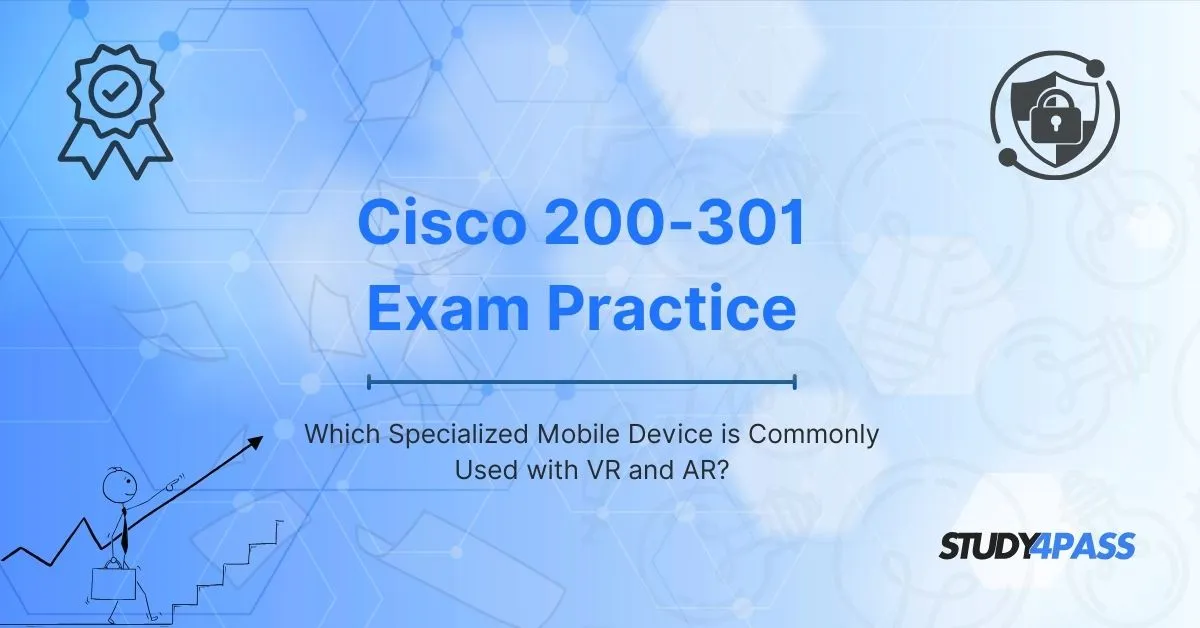Introduction To Cisco 200-301 Exam Practice
Virtual Reality (VR) and Augmented Reality (AR) are transforming industries, from gaming and education to healthcare and engineering. A crucial component of these immersive experiences is the specialized mobile device that powers them. But which device is most commonly used with VR and AR?
In this blog, we’ll explore the leading mobile devices for VR and AR, their features, and how they enhance immersive experiences. Plus, if you're preparing for the Cisco 200-301 exam, we’ll discuss how Study4Pass can help you ace your certification with the best Cisco 200-301 Exam Practice resources.
What Are VR and AR?
Before diving into the devices, let’s clarify the difference between VR and AR:
Virtual Reality (VR): A fully immersive digital environment that replaces the real world. Users typically wear a VR headset.
Augmented Reality (AR): Overlays digital elements onto the real world, often viewed through smartphones or AR glasses.
Both technologies require powerful hardware for smooth performance.
The Most Common Mobile Device for VR and AR: Smartphones
While dedicated VR headsets (like Oculus Rift or HTC Vive) and AR glasses (like Microsoft HoloLens) exist, Exam Prep Practice Test are the most widely used mobile devices for VR and AR due to their accessibility and advanced sensors.
Why Smartphones?
1. Built-in Sensors – Accelerometers, gyroscopes, and depth sensors enable motion tracking.
2. High-Resolution Displays – Essential for clear AR overlays and VR immersion.
3. Processing Power – Modern smartphones have powerful CPUs and GPUs to handle AR/VR apps.
4. Portability – Unlike bulky headsets, smartphones are easy to carry and use anywhere.
Popular Smartphones for VR and AR
iPhone (iOS): iPhones (especially Pro models) have LiDAR scanners for precise AR.
Samsung Galaxy (Android): High refresh rates and AMOLED screens enhance VR.
Google Pixel: Optimized for ARCore (Google’s AR platform).
Dedicated VR/AR Headsets vs. Smartphones
While smartphones are common, dedicated headsets offer deeper immersion:
|
Device Type |
Pros |
Cons |
|
Smartphones |
Affordable, portable, no extra hardware needed |
Limited immersion, lower FOV (Field of View) |
|
VR Headsets (Oculus Quest, HTC Vive) |
Full immersion, better tracking, high FOV |
Expensive, requires a powerful PC (for some models) |
|
AR Glasses (Microsoft HoloLens, Magic Leap) |
Hands-free AR, advanced spatial mapping |
Very expensive, limited consumer availability |
How Study4Pass Helps with Cisco 200-301 Exam Practice
While VR and AR are reshaping tech, networking remains a critical skill. If you're preparing for the Cisco 200-301 CCNA exam, Study4Pass offers the best Cisco 200-301 exam practice resources, including:
Real Exam Simulations – Practice tests that mimic the actual exam.
Detailed Explanations – Understand why answers are correct.
Performance Tracking – Identify weak areas and improve.
Up-to-Date Content – Aligned with the latest exam objectives.
With Study4Pass, you can gain the confidence and knowledge needed to pass the Cisco 200-301 Certification on your first try!
Future of VR and AR Mobile Devices
The next generation of VR and AR devices will likely include:
- 5G-enabled smartphones for faster cloud-based AR/VR.
- Foldable phones with larger screens for better immersion.
- Lightweight AR glasses that replace smartphones entirely.
As technology advances, mobile devices will continue to be the primary gateway to VR and AR experiences.
Conclusion
Smartphones are the most common mobile devices used for VR and AR due to their affordability, portability, and powerful hardware. While dedicated headsets offer deeper immersion, smartphones remain the most accessible option for everyday users.
Special Discount: Offer Valid For Limited Time “200-301 Exam Prep Practice Test”
Sample Questions for Cisco 200-301 Exam
Actual exam question from Cisco's 200-301 Exam Prep Practice Tests
What is the most effective way to practice for the Cisco 200-301 exam?
A) Memorizing answers from unauthorized "Cisco 200-301 exam prep practice test"
B) Using official Cisco practice tests and hands-on lab exercises
C) Relying solely on YouTube videos without practical application
D) Guessing answers without understanding networking concepts


